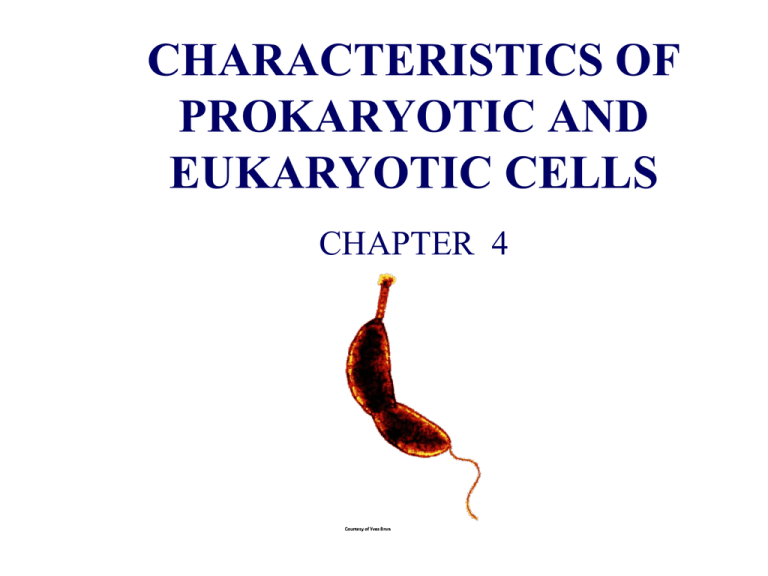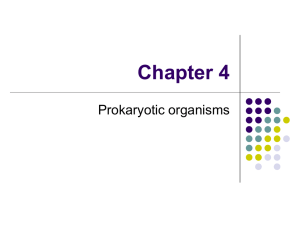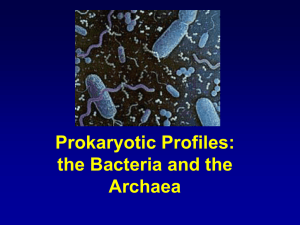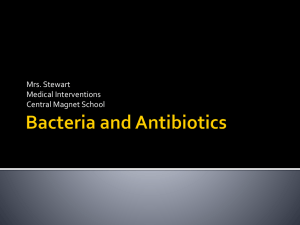
CHARACTERISTICS OF
PROKARYOTIC AND
EUKARYOTIC CELLS
CHAPTER 4
Detailed studies of cells have revealed that
prokaryotes differ enough to be split into two
large groups called domains. A relatively new
concept in classification, domain is the highest
taxonomic category, higher even than kingdom.
Three domains exist:
• Archaea (archaeobacteria)
• Bacteria (eubacteria)
• Eukarya
Archaea and Bacteria are both
prokaryotes. The comparison in the
next few slides is between bacteria
and Eukaryotic cells. We will deal
with archaea in a following slide.
Basic Cell Types:
Prokaryotic are cells that lack a nucleus (nuclear
membrane). Prokarotic cells are single cells but are subdivided
into Bacteria and Arachaea as mention in the previous slide.
Eukaryotic cells contain a nucleus (nuclear membrane).
Eukaryotic cells include: plants, animals, fungi and protists ( a
very heterogeneous group that are neither animals, plants or
fungi and are often single cell and small e.g., protozoa).
Prokaryotes (Bacteria) and Eukaryotes have many similarities
and many differences:
Cellular Characteristics
Cellular Characteristics
Size: Most prokaryotes range from 0.5 to 2.0 µm in diameter.
A human red blood cell is about 7.5 µm.
Shape
Bacteria which show a wide variety of shapes within a single species are said to be
Pleomorphic. Those of you taking the laboratory will see the various shapes of bacteria
first-hand.
Fig. 4.1 The most common bacterial shapes
Fig. 4.2 Arrangements of some of
The more common cocci forms
of bacteria
An overview of structure
1. Cell membrane-typically surrounded by a cell wall
2. Internal cytoplasm with ribosomes, a nuclear region and granules
3. Lots of external structure, e.g., capsules, flagella and pili
Fig. 4.3 A typical prokaryotic cell
1. Cell membrane-typically surrounded by a cell wall
2. Internal cytoplasm with ribosomes, a nuclear region and granules
3. Lots of external structure, e.g., capsules, flagella and pili
Fig. 4.3 A typical prokaryotic cell
http://www.youtube.com/watch?v=9JVyIjpUybs&feature=relmfu
Gram stain
http://www.youtube.com/watch?v=Oc6bo2fo0ag&playnext=1&list=PL08D2F3AB65E39C37
Capsule stain
http://www.youtube.com/watch?v=a9HF4aM5QHk&feature=relmfu
Endospore stain
http://www.youtube.com/watch?v=qmHvblk0kZo&feature=relmfu
Acid fast stain
For those of you not in the laboratory these videos will show you how the stains are done and how
stained cells appear. I will not test you on this material but may reference one of these stains in
describing an organism.
http://www.youtube.com/watch?v=Dv6J-8Vi2t4
Pili and bacterial attachment
The Cell Wall
The semi-rigid cell wall lies outside the cell membrane in nearly all
bacteria (Mycoplasma being an exception).
A. maintains cell shape
B. acts as a corset in preventing cells from
bursting in hypotonic solution (you can store a culture of E. coli
in distilled water for weeks to months)
C. it is quite porous and has little effect on the
inflow and outflow of materials
Peptidoglycan- the structure that gives shape and strength
to bacteria. Many bacteria can be stored in distilled water
because that have a peptidoglycan "corset". Gram positive
and Gram negative organisms have somewhat different
peptidoglycan layers as we will see on the next slide. The
peptidoglycan layer permits bacteria, e.g., E. coli to be
stored in hypotonic solutions, e.g., distilled water, for
weeks.
Gram negative peptidoglycan
(E. coli) which is basically a two-dimensional structure
because it lacks the pentaglycine cross-linker of Gm + orgs.
Fig. 4.4 A-two dimensional view of Gram negative wall,
Fig. 4.4B- A three-dimensional view of peptidoglycan for Gram positive bacteria
Periplasmic space - A gap between the cell wall and the
cytoplasmic membrane most easily observed in Gram
negative organisms since they have a double membrane
and is not characteristically considered a feature of gram
positive organisms although some refer to the space
between inner and outer leflets of the plasma membrane of
Gram positive organisms as a periplasmic space (I do not).
It is a region of high enzymatic activity containing many
digestive enzymes and transport proteins. It is also a region
that is outside of the normal array of digestive enzymes
associated with the cytoplasm (in particular certain
proteolytic enzymes). We will see it in fig. 4.6b
Distinguishing Bacteria by Cell WallsGram negative and Gram positive
http://www.youtube.com/watch?v=QEc2aUaD25w
Peptidoglycan layer Gm + and Gm -
Fig. 4.6a Gram positive cell wall
* Teichoic acid a polymer of glycerol,
phosphate and ribitol occurs in units up to
30 units long extends beyond the cell wall
Only found in Gm +
organisms, but not all
Gram + organism
contain teichoic acid.
Gram Negative Cell Walls
• Outer Membrane
• Periplasmic space
– Digestive Enzymes
– Protein pumps
• LPS components
Fig. 4.6b Gram negative cell wall
Although we will deal with antibiotics that block cell wall synthesis in another chapterhaving seen how the cell wall is synthesized how penicillin block cell wall synthesis would be
in order (even though we will see it again in the antibiotic chapter).
How penicillin inhibits cell wall synthesis
http://www.youtube.com/watch?v=4EJEr_lt5dM
Acid Fast Cell Wall
Acyl lipids
lipoarabinomannan (LAM)
Mycolic acid
arabinogalactan
peptidoglycan
The complex structure of the acid fast
cell wall makes it a good barrier
against many physical agents, such as
phagocytic cell digestion, penetration
by antibacterial agents.
Lipid bilayer
lipoarabinomannan (LAM) is a glycolipid, and a virulence factor associated
with Mycobacterium tuberculosis, the bacteria responsible for tuberculosis. Its
primary function is to inactivate macrophages and scavenge oxidative
radicals. Mycolic acid is also associated with the virulence of M. tuberculosis.
Mycobacterium tuberculosis (TB organism is an acid fast organism )
Fig. 4.6c-Acid fast cell wall
*
Prokaryotic Plasma Membrane
• Phospholipids
• Fluid Mosaic
Several reasons why this generic structure looks more like a eukaryotic plasma membane
than a prokaryotic one
Fig. 4.7 The fluid-mosaic model of the cell membrane-
The Cytoplasm-semi-fluid substance inside the cell membrane.
Cytoplasm is about four-fifths water and one-fifth substances
dissolved or suspended in the water (enzymes, carbohydrates, lipids,
inorganic ions as well as containing ribosomes and chromosomes.
Ribosomes- consist of ribonucleic acid and protein.
Contain two subunits a large (50S) and a small (30S). What
does S stand for? The intact ribosome with both subunits is a 70S
particle. The relative size is determined by measuring their
sedimentation rates-the rates at which they move toward the bottom
of a tube, containing a concentration gradient of a viscous substance
like sucrose, when the tube is rapidly spun. Certain antibiotics such
as streptomycin and erythromycin bind to the 70S ribosome;
and disrupt protein synthesis. Because those antibiotics largely
do not affect the 80S ribosomes found in eukaryotic cells, they
kill bacteria without harming host cells- at therapeutic
concentrations.
chromosome
Fig. 4.9 The bacterial nuclear region
Internal membranes: Bacteria do not contain free-standing organelles but some (photosynthetic bacteria and
nitrifying bacteria contain extensive membrane systems derived from the plasma membrane which contain
enzymes for photosynthesis or for the oxidation of nitrogen containing compounds. These membranes are
invaginations of the plasma membrane and are not free standing membranes.
Fig. 4.10 Internal membrane system
Inclusions
• Chromatophores
• Metachromatic
granules
• Vesicles
Polar Lipids of Chromatium Strain D Grown at Different Light Intensities
S. Steiner, J. C. Burnham,1 S. F. Conti, and R. L. Lester, J Bacteriol. 103, 500-503
Under high light intensity
the vesicles disappear but
there is no change in the
amount of phospholipid/cell as
compared to the cells below.
How would you interpret
These results?
Chromatium packed with
Photosynthetic vesicles. All
of which are associated
with the surface membrane
Inclusions-termed granules and vesicles (characteristic of some
organisms not present in most (aside from ribosomes)).
a. glycogen
b. polyphosphate- termed metachromatic granules or
volutin
c. chromatophores
d. vesicles that contain poly-b –hydroxybutyrate
e. lipid deposits
f. ribosomes (70S= 50S + 30S)
g. magnetic inclusions (Fe3O4)
Endospores
Vegetative cells of certain species Bacillus and
Clostridium produce resting stages called
endospores.. These spores help the organisms
overcome an adverse situation and are not very
useful for reproduction since there is only a single
spore per cell. In contrast, fungi typically produces
numerous spores and are therefor useful as a
means of reproduction.
Endospores are highly dehydrated and it is
likely this properties that makes them so resistant
to heat, drying, acids and bases, and even
radiation.
Sporulation
http://www.youtube.com/watch?v=UHsqFjP1dZg&feature=related
Fig. 4.11 Endospores
Vaccines Could Have Stopped These Outbreaks (MAP)
Each dot on the map represents at least one case of a vaccine-preventable disease from 2006 - 2013. Larger dots represent hundreds or even
thousands of cases. Cases of the measles are represented by red dots, the mumps by brown dots, rubella by blue, polio by gold, whooping
cough by bright green and everything else by bright yellow.
Dipicolinic acid (pyridine-2,6-dicarboxylic acid) is a
chemical compound which composes 5% to 15% of the
dry weight of bacterial spores. It is implicated as
responsible for the heat resistance of the endospore
However, mutants resistant to heat but lacking
dipicolinic acid have been isolated, suggesting other
mechanisms contributing to heat resistance are at
work. Spore core dehydration is a primary
determinant of heat resistance. Remember that
hydrolysis is the major mechanism by which complex
molecules are broken down by enzymatic activity.
Hence, if there is no water there is no hydrolysis.
EXTERNAL STRUCTURES
Pseudomonas
Spirillum
Spirillum
Monotrichous single
flagellum at one end
Amphitrichous- single
flagellum at each end
Lophotrichous-tuft
of flagella at one or
both ends
Salmonella
Peritrichous- Flagella
distributed all over
Scanning SEM of peritrichous
Fig. 4.12 Arrangement of bacterial flagella
The bacterial flagellum is driven by a rotary
engine (the Mot complex) made up of protein,
located at the flagellum's anchor point on the
inner cell membrane. The engine is powered by
proton motive force, i.e., by the flow of protons
(hydrogen ions) across the bacterial cell
membrane due to a concentration gradient set up
by the cell's metabolism (in Vibrio species there
are two kinds of flagella, lateral and polar, and
some are driven by a sodium ion pump rather
than a proton pump[18]). The rotor transports
protons across the membrane, and is turned in
the process.
Flagellar structure and function
A primitive but
effective mode of cells
being able to
recognize a chemical
signal. As organisms
evolved that kind of
signal recognition
became more
important for a wide
range of extracellular
signals.
Fig. 4.14 chemotaxis-above is positive chemotaxis
Signal transduction that both triggers
and blocks chemotaxis and can
respond to multiple signals
Attractant binding
P2
P2
The flagellar motor is driven by
methylation/demethylation and
phosphorylation/dephosphorylation
P
CheR adds
methyl groups
Chemotactic activation pathway- not in your text
Take home lesson: bacterial chemotaxis, is
a signal transduction system which involves
phosphorylation/dephosphorylation and methylation/demethylation regulatory controls. Do not
worry about the details of this diagram just understand the major points indicated
above, i.e., signal transduction system and generally how it functions.
Neutrophil chemotaxis
http://www.youtube.com/watch?v=EpC6G_DGqkI
Spirochetes have axial filaments or endoflagellum, instead of flagella
that extend beyond the cell wall. They are contained within a sheath and
cause the rigid spirochete body to rotate like a corkscrew when they twist
inside the outer sheath. Put lophotrichous flagella on the side of a
bacterium and wrap plastic wrap around it- gives you some idea of how
it works.
Fig. 4.15 Axial filaments, or endoflagella
Pili- are tiny hollow projections
Attachment pili.- help bacteria adhere to
surfaces and contribute to the pathogenicity of certain
bacteria. For example, Neisseria. gonorrhea,
enterotoxigenic Escherichia.coli among others.
Organism must attach to cells
to cause disease- fimbrae or pili
are very important for the
attachment
Fig. 4.16 Pili.
Conjugation pili (or sex pilus) hollow tube through which DNA is
transferred from + to - cell during bacterial mating
Capsule surrounding a rodshaped bacterium
- a secreted protective structure
outside the cell wall of an
organism. Capsule is very
important in the pathogenesis of a
number of organisms such as,
Streptococcus pneumonia, Bacillus
anthracis.
Figure 3.3 of negative-staining of capsules
Slime layer- less tightly bound to the cell
wall and usually thinner than a capsule.
When present it protects the cell against
drying, helps trap nutrients near the cell,
and sometimes binds cells together. Slime
layers allow bacteria to adhere to objects in
their environments, such as rock surfaces,
teeth, or the root hairs of plants, so that
they can remain near sources of nutrients
or oxygen.
EUKARYOTIC CELLS- I will not cover this
material because it is the focus of BIO 315Cell Biology. Moreover, most of what you
need to know for this course has been taught
in BIO 150 or its equivalent.
concentration gradient
Facilitate diffusion Carrier protein molecules aid in the movement of
substances through the cell membrane, but only down a concentration
gradient. This process does not require the expenditure of energy
Fig. 4.29 Facilitated diffusion
Endocytosis and exocytosis- endocytosis is the process of taking materials into the cell;
exocytosis is the process of releasing materials from the cell. Amantadine- blocks virus uptake
by endocytosis. The mechanism of Amantadine's antiviral activity involves interference
with a viral protein, M2 (an ion channel),[which is required for the viral particle to become
"uncoated" once taken inside a cell by endocytosis.
Fig. 4.33 Endocytosis and exocytosis- associated with eukaryotic
cells- (viruses are often taken up in this manner)










